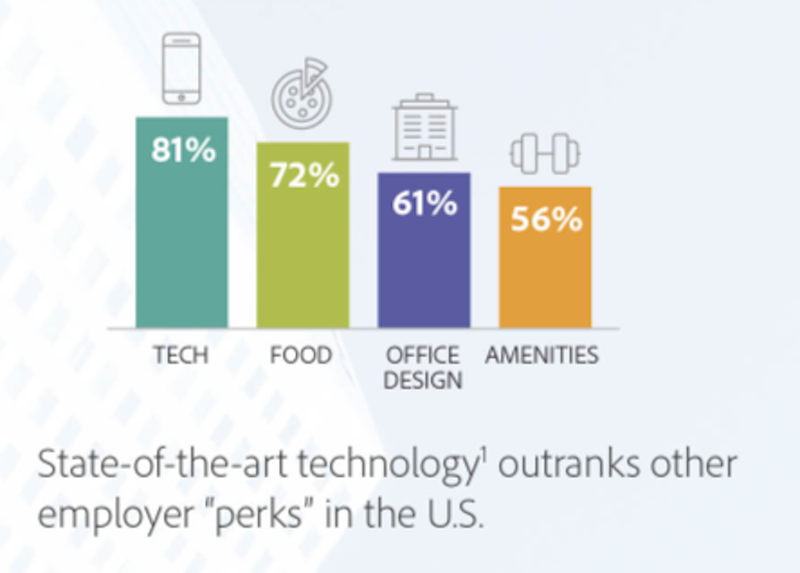American office workers love their jobs, and love them even more when the technology their companies use is viewed as being ahead of the curve.
A recent online survey of more than 1,000 office workers in the U.S., which Adobe conducted during two weeks last month, finds 70% saying they love what they do. And a remarkable 81% say that state-of-the-art technology was more important to them than an office’s design or on-site amenities.
Seven out of 10 U.S. workers believe technology improves the work-life balance, and 81% say technology helps them connect with colleagues more efficiently. Those respondents who think their company’s technology is “ahead of the curve” feel about twice as creative, motivated, and satisfied as respondents who work for companies with less-than-cutting edge technology.
The rub is that only 25% of the survey’s U.S. respondents think their company’s technology excels. Nevertheless, more than half (53%) expects technology to be handling more of their offices’ menial tasks—copying, filing, etc.—over the next two decades, even as 55% remain convinced their jobs could never be replaced by a machine.
In fact, there seems to be more than a hint of ambivalence about the benefits of technology among the 75% of respondents who are concerned that relationships and health suffer when people become to attached to their devices.

Technology trumps other office amenities in what keeps workers content. Image: Adobe's “Work in Progress” report.
The Adobe survey portrays an American workforce for which work and life are inseparable, almost to the point of obsession. More than half of the respondents say they’d keep working if they won the lottery. U.S. workers say they spend, on average, 78% of their waking hours during the work week and 41% of their days off thinking about their jobs. Indeed, 57% of respondents agree with the statement “work defines who I am.”
The desire to work is further punctuated by the finding that one in three U.S. office workers moonlights in jobs outside of his or her primary occupation, and that moonlighters are more likely to be happier and more optimistic than non-moonlighters.
However, 69% of U.S. workers also say they work multiple jobs because they need the money. Nearly three-fifths of American workers are likely to leave their jobs for a better opportunity. (That number is 50% even among people who say they profess love for their current job.)
Related Stories
| Aug 11, 2010
NoricF4 custom metal ICF frames receive fire ratings, comply with antiterrorism standards for buildings
Reward Wall Systems' NoricF4 Custom Metal ICF Frames have received fire ratings of 1.5 hours to 3 hours and they have been evaluated to be in compliance with the prescriptive requirements of the Department of Defense Minimum Antiterrorism Standards for Buildings for blast/force protection.
| Aug 11, 2010
Nation's first set of green building model codes and standards announced
The International Code Council (ICC), the American Society of Heating, Refrigerating and Air Conditioning Engineers (ASHRAE), the U.S. Green Building Council (USGBC), and the Illuminating Engineering Society of North America (IES) announce the launch of the International Green Construction Code (IGCC), representing the merger of two national efforts to develop adoptable and enforceable green building codes.
| Aug 11, 2010
Earthquake engineering keeps airport grounded
Istanbul, Turkey's new 2.15 million-sf Sabiha Gökçen International Airport opened on October 31, 2009, becoming the world's largest seismically isolated building. Arup's global airport planning and engineering team, in collaboration with architects Dogan Tekeli Sami Sisa Mimarlik Ofisi and contractor LIMAK-GMR JV, working within an 18-month timeline, designed and built the facility wi...
| Aug 11, 2010
New Ways to Improve Water Efficiency
In the U.S. and most of the industrialized world, building occupants take for granted the simple convenience of filling a glass with clean, drinkable water at the kitchen sink. Yet worldwide, nearly a billion people globally have no access to safe drinking water, according to the Natural Resources Defense Council.
| Aug 11, 2010
Embassy's dual façades add security and beauty
The British government's new 46,285-sf embassy building in Warsaw, Poland's diplomatic quarter houses the ambassador's offices, the consulate, and visa services on three floors. The $20 million Modernist design by London-based Tony Fretton Architects features a double façade—an inner concrete super structure and an outer curtain wall.
| Aug 11, 2010
Cost of HVAC equipment to remain flat in 2009, says Turner
While some manufacturers have announced slight increases in facilities equipment pricing for 2009, the average cost of equipment is expected to remain flat in 2009, according to the 2009 Turner Logistics Equipment Cost Index. However, equipment pricing could face increased pressure if there is a further decline in market demand.
| Aug 11, 2010
Toronto mandates green roofs
The city of Toronto late last month passed a new green roof by-law that consists of a green roof construction standard and a mandatory requirement for green roofs on all classes of new buildings. The by-law requires up to 50% green roof coverage on multi-unit residential dwellings over six stories, schools, nonprofit housing, and commercial and industrial buildings.
| Aug 11, 2010
Robotic storage facility protects exotic automobiles, fine wines, artwork
Miller Construction Company, Fort Lauderdale, Fla., has completed construction on a high-tech robotic storage facility designed to store and protect valued possessions such as exotic automobiles, fine wines, artwork, and jewelry. Designed and built to resist Category 5 hurricanes, the RoboVault facility features automated storage retrieval, biometric recognition, private access with 24/7 securi...
| Aug 11, 2010
7 Tips for Installing Moisture Barriers
If you took a poll of building envelope and construction forensic experts, it's likely that moisture barriers would be high on the list of most poorly understood products used in wall assemblies. Besides deciding which type of barrier to use under various climate conditions, Building Teams must confront the nasty matter of how to install them correctly.







